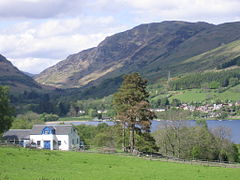Lochearnhead
Lochearnhead
|
|
|---|---|
 Lochearnhead and Glen Ogle |
|
| Lochearnhead shown within the Stirling council area | |
| OS grid reference | NN590235 |
| Civil parish | |
| Council area | |
| Lieutenancy area | |
| Country | Scotland |
| Sovereign state | United Kingdom |
| Post town | LOCHEARNHEAD |
| Postcode district | FK19 |
| Dialling code | 01567 01877 |
| Police | Scottish |
| Fire | Scottish |
| Ambulance | Scottish |
| EU Parliament | Scotland |
| UK Parliament | |
| Scottish Parliament | |
Lochearnhead (Scottish Gaelic: Ceann Loch Èireann) is a village on the A84 Stirling to Crianlarich road at the foot of Glen Ogle, 14 miles (23 km) north of the Highland Boundary Fault. It is situated at the western end of Loch Earn where the A85 road from Crieff meets the A84.
Loch Earn is 317 ft above sea level, with the settlement running from its shores up to higher ground on the hills at the mouth of Glen Ogle. Lochearnhead lies within the Breadalbane area of the Loch Lomond and the Trossachs National Park.
The first evidence of people in Lochearnhead comes from Mesolithic arrowheads found in Glen Ogle by former local policeman Tom Gibbon, and his son Donald. A settled population is in evidence in the Neolithic period, from a burial chamber at Edinchip, and from the cup-marked stones which lie between the Kendrum Burn and the Craggan Road, in what is known locally as the Druid Field. There is another site with cup and ring marks at the head of Glen Ogle.
There are two crannogs still visible on Loch Earn, one at the west end of the loch in Carstran Bay, below Edinample Castle, the other at the east end of the loch, at St Fillans, known as Neish Island. (Other submerged possible crannog sites also exist, and recent surveys by the Scottish Crannog Centre and others suggest the known number may increase if the archaeology is enabled to go ahead). These man-made islands probably date from the Bronze Age, although Neish Island was inhabited (latterly by the Clan Neish, for whom it is now named) until 1612.
Loch Earn was on the frontier between Pictland and Dalriada, or Dál Riata, the kingdom of the incoming Scots from Ireland, Dundurn at the east end of the loch being a Pictish frontier fort. This lends weight to the argument that the name Earn therefore comes from Eireann, in other words “the loch of the Irish”.
...
Wikipedia

